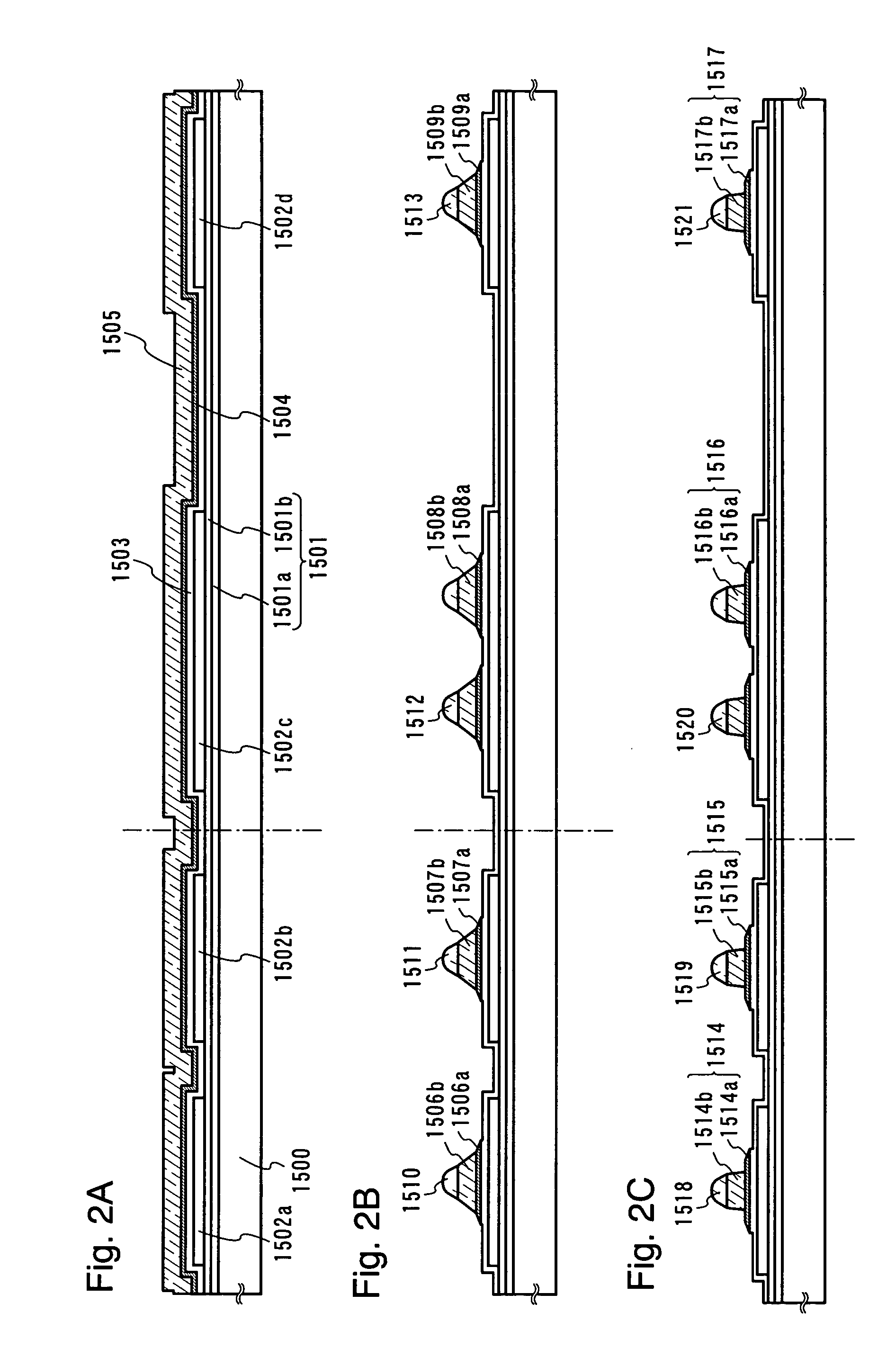Display device and manufacturing method thereof
a technology of a display device and a manufacturing method, applied in the direction of semiconductor devices, basic electric elements, electrical apparatus, etc., can solve the problems of indium tin oxide not crystallizing, crystalline components remaining as residues after wet etching, and amorphous
- Summary
- Abstract
- Description
- Claims
- Application Information
AI Technical Summary
Benefits of technology
Problems solved by technology
Method used
Image
Examples
embodiment 1
[0050] (Embodiment 1)
[0051] In the present embodiment, a method of manufacturing a light-emitting device according to the present invention is used to describe a method of manufacturing an active matrix display device that has a thin film transistor and a light-emitting element with reference to FIGS. 2A to 6B.
[0052] On a substrate 1500, a laminate of a base insulating film 1501a formed to have a film thickness from 50 to 100 nm and a base insulating film 1501b formed to have a film thickness from 50 to 100 nm is formed (FIG. 2A). The base insulating film 1501 (1501a and 1501b) is formed in order to prevent impurity diffusion from the substrate 1500 to a semiconductor layer. In the present embodiment, low alkali glass is used, and a silicon nitride film with a film thickness of 100 nm and a silicon oxide film with a film thickness of 100 nm are respectively formed by plasma CVD as the base insulating film 1501a and the base insulating film 1501b. Although the base insulating film ha...
embodiment 2
[0096] (Embodiment 2)
[0097] In the present embodiment, a display device that has a different structure from Embodiment 1 will be described with reference to FIG. 9.
[0098] In FIG. 9, wirings (or electrodes) 1735 for transmitting electrical signals to respective TFTs are formed above an electrode 1738 of a light-emitting element, which is formed to have a first transparent conductive film 1736 and a second transparent conductive film 1737. In the case of the display device that has the foregoing structure, the wirings (or electrodes) 1735 are formed after forming the electrode 1738 of the light-emitting element. In FIG. 9, layers to be formed above the electrode 1738 of the light-emitting element such as an insulating film and a light-emitting layer are not shown.
[0099] Therefore, a solution such as a strong acid solution of iron chloride can be also used to process the first transparent conductive film 1736 and the second transparent conductive film 1737. However, in consideration of...
embodiment 3
[0102] (Embodiment 3)
[0103] In the present embodiment, a display device that has a different structure from Embodiments 1 and Embodiment 2 will be described with reference to FIG. 10.
[0104] In FIG. 10, wirings (or electrodes) 1835 for transmitting electrical signals to respective TFTs are provided on a first interlayer insulating film (1860 and 1861), a second interlayer insulating film (1862 and 1863) is provided on the wirings (or electrodes) 1835, and an electrode 1838 of a light-emitting element is provided on the second interlayer insulating film (1862 and 1863). The electrode 1838 of the light-emitting element includes a first transparent conductive film 1836 and a second transparent conductive film 1837. The second interlayer insulating film (1862 and 1863) has a two-layer structure of an organic resin film 1862 such as acrylic or polyimide and a silicon nitride film 1863 formed thereon by sputtering. In FIG. 10, layers to be formed above the electrode 1838 of the light-emitt...
PUM
| Property | Measurement | Unit |
|---|---|---|
| work function | aaaaa | aaaaa |
| thickness | aaaaa | aaaaa |
| specific resistance | aaaaa | aaaaa |
Abstract
Description
Claims
Application Information
 Login to View More
Login to View More - R&D
- Intellectual Property
- Life Sciences
- Materials
- Tech Scout
- Unparalleled Data Quality
- Higher Quality Content
- 60% Fewer Hallucinations
Browse by: Latest US Patents, China's latest patents, Technical Efficacy Thesaurus, Application Domain, Technology Topic, Popular Technical Reports.
© 2025 PatSnap. All rights reserved.Legal|Privacy policy|Modern Slavery Act Transparency Statement|Sitemap|About US| Contact US: help@patsnap.com



